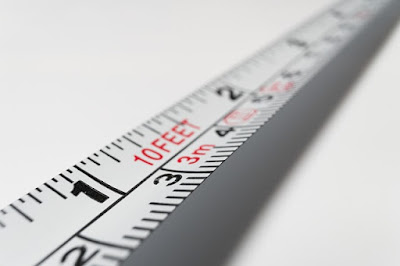 |
| Measurement - General Science Notes |
Measurement is the process of comparing an unknown physical quantity with respect to a known quantity. This known quantity is simply known as a standard unit of the physical quantity.
There are two type of physical quantities.
1. Fundamental physical quantities
Those physical quantities which do not depend on other quantities and also independent of each other. They are seven in number viz; length, mass, time, temperature, electric current, luminous intensity and amount of substance.
2. Derived physical quantities
Those physical quantities which are derived from fundamental physical quantities. For example, speed is derived from the fundamental quantities length and time, hence it is a derived physical quantity.
On the basis of physical quantities, there are two type of measuring units.
1. Fundamental Units
Those units which cannot be derived from any other unit, and resolved into any basic or fundamental unit. The the units of fundamental physical quantities are called fundamental units.
| Base quantity | SI unit | Symbol |
|---|---|---|
| Length | metre (m) | l |
| Mass | kilogram (kg) | m |
| Time | second (s) | t |
| Electric current | ampere (A) | I |
| Temperature | kelvin (K) | T |
| Amount of substance | mole (mol) | n |
| Luminous intensity | candela (cd) | L |
2. Derived unit
Any unit which is the combination of one or more fundamental units are called derived unit. For example, Newton (Force), Ohm (resistance), and Kilowatt/hour (Energy).
| Name | Symbol | Quantity | In SI base units |
|---|---|---|---|
| radian | rad | angle | (m⋅m-1) |
| steradian | sr | solid angle | (m2⋅m-2) |
| hertz | Hz | frequency | s-1 |
| newton | N | force, weight | kg⋅m⋅s-2 |
| pascal | Pa | pressure, stress | kg⋅m−1⋅s-2 |
| joule | J | energy, work, heat | kg⋅m2⋅s-2 |
| watt | W | power, radiant flux | kg⋅m2⋅s-3 |
| coulomb | C | electric charge or quantity of electricity | s⋅A |
| volt | V | voltage (electrical potential), emf | kg⋅m2⋅s-3⋅A-1 |
| farad | F | capacitance | kg−1⋅m−2⋅s4⋅A2 |
| ohm | Ω | resistance, impedance, reactance | kg⋅m2⋅s-3⋅A-2 |
| tesla | T | magnetic flux density | kg⋅s-1⋅A-1 |
| degree Celsius | °C | temperature relative to 273.15 K | K |
| lumen | lm | luminous flux | cd |
| lux | lx | illuminance | m-2⋅cd |
| becquerel | Bq | radioactivity (decays per unit time) | s-1 |
| katal | kat | catalytic activity | mol⋅s-1 |
Also check: List of Physical Quantities
System of Units
There are four widely known system of units.
1. CGS (centimeter, gram, and second)
2. MKS (meter, kilogram, and second)
3. FPS (foot, pound, and second)
4. SI (Systeme Internationale d′ Unites)
The first three systems only recognizes, Mass (M), Length (L), and Time (T), while SI system recognizes seven fundamental units, which include electric current (A), thermodynamic temperature (K), amount of substance (mol) and luminous intensity (I), along with aforementioned three, mass, length, and time.
The SI unit system was first introduced in 1948, and officially adopted internationally in 1960.
Alongwith seven basic units, there are two supplementary units: first, radian for measuring plane angles, and second stredian for measuring solid angles.
Other practical units of use
Astronomical unit (AU): The average distance between the sun and the earth (1.49 × 1011 m) is known as 1 Astronomical Unit.
Parsec: The distance at which a star would have a parallax angle equal to one second of arc is known as parsec. (1 Parsec = 3.08568025 × 1016 m).
Light year: It is the distance travelled by light in one year. All electromagnetic waves travel at a speed of 299,792,458 ms-1 and an average year being 365.25 days.
One light year is 299,792,458 × 108 ms-1 × (365.25 × 24 × 60 × 60)s = 9.46073 × 1015 m. or 9.46073 × 1012 km.
Angstrom: It is a unit of length used to measure small lengths such as the wavelengths of light, atoms, and molecules. (1 Å =10-10 m)
Fermi: A unit of length used to measure nuclear distance = 10-15 meter, 1 fermi = 10-15m.
Prefixes for SI unit
In science, we have to deal with mind boggling range of large or small number such as .0000000000007 or 7000000000000. It is not practical to express these numbers in simple terms. So we use certain prefixes to easily define these numbers.
| Name | Symbol | Base 10 |
|---|---|---|
| yotta | Y | 1024 |
| zetta | Z | 1021 |
| exa | E | 1018 |
| peta | P | 1015 |
| tera | T | 1012 |
| giga | G | 109 |
| mega | M | 106 |
| kilo | k | 103 |
| hecto | h | 102 |
| deca | da | 101 |
| 100 | ||
| deci | d | 10-1 |
| centi | c | 10-2 |
| milli | m | 10-3 |
| micro | µ | 10-6 |
| nano | n | 10-9 |
| pico | p | 10-12 |
| femto | f | 10-15 |
| atto | a | 10-18 |
| zepto | z | 10-21 |
| yocto | y | 10-24 |
Errors in measurement
Generally measured value is different from true of the physical quantitiy. The difference between true value and measured value is known as error.
Error = true value – measured value
Error Percentage (error %) = (error*100)/true value
Precision refers to the closeness of various measurements for the same quantity. On other hand, accuracy is the agreement of a particular value to the true value of the result.
